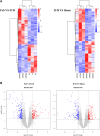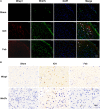High-Throughput mRNA Sequencing Reveals Potential Therapeutic Targets of Febuxostat in Secondary Injury After Intracerebral Hemorrhage
- PMID: 35814252
- PMCID: PMC9260037
- DOI: 10.3389/fphar.2022.833805
High-Throughput mRNA Sequencing Reveals Potential Therapeutic Targets of Febuxostat in Secondary Injury After Intracerebral Hemorrhage
Abstract
Febuxostat is a urate-lowering medication for the treatment of patients with gout. This study was performed to elucidate the effects and underlying mechanisms of febuxostat on neuronal injury induced by intracerebral hemorrhage (ICH) in mice. The results showed that the administration of febuxostat improved neurological severity scores and blood-brain barrier (BBB) permeability. Moreover, febuxostat attenuated neuronal cell death and cytokine levels compared with the ICH group. Next, we conducted a transcriptome analysis of the neuroprotective effects of febuxostat. The overlapping significant differentially expressed genes (DEGs) were identified. Gene ontology (GO) analysis revealed that the overlapping significant DEGs were most enriched in five items. The intersecting DEGs of the aforementioned five pathways were Wisp1, Wnt7b, Frzb, and Pitx2. In addition, GO terms and Kyoto Encyclopedia of Genes and Genomes (KEGG) pathways revealed that DEGs were mainly involved in the wnt signaling pathway. Furthermore, the expression of Wisp1 and Wnt7b in the perihematomal region at 72 h post-ICH was observed. The results showed that both Wisp1 and Wnt7b were increased in the ICH group and were decreased by the administration of febuxostat. Taken together, the study showed that febuxostat protected against secondary brain injury after ICH and the Wnt7b-Wisp1 pathway was closely related to neuroprotective effects.
Keywords: Wisp1; febuxostat; high-throughput mRNA sequencing; intracerebral hemorrhage; neuroprotection.
Copyright © 2022 Wang, Zhang, Li, Xu, Xiang, Bai, Zhang, Wang, Zhang and Liao.
Conflict of interest statement
The authors declare that the research was conducted in the absence of any commercial or financial relationships that could be construed as a potential conflict of interest.
Figures







Similar articles
-
Activation of Frizzled-7 attenuates blood-brain barrier disruption through Dvl/β-catenin/WISP1 signaling pathway after intracerebral hemorrhage in mice.Fluids Barriers CNS. 2021 Sep 26;18(1):44. doi: 10.1186/s12987-021-00278-9. Fluids Barriers CNS. 2021. PMID: 34565396 Free PMC article.
-
Identification of hub genes and small-molecule compounds related to intracerebral hemorrhage with bioinformatics analysis.PeerJ. 2019 Oct 25;7:e7782. doi: 10.7717/peerj.7782. eCollection 2019. PeerJ. 2019. PMID: 31667013 Free PMC article.
-
Febuxostat, a xanthine oxidase inhibitor, regulated long noncoding RNAs and protected the brain after intracerebral hemorrhage.Neuroreport. 2023 Oct 4;34(14):703-712. doi: 10.1097/WNR.0000000000001945. Epub 2023 Aug 8. Neuroreport. 2023. PMID: 37556585
-
Identification of Candidate Blood mRNA Biomarkers in Intracerebral Hemorrhage Using Integrated Microarray and Weighted Gene Co-expression Network Analysis.Front Genet. 2021 Jul 19;12:707713. doi: 10.3389/fgene.2021.707713. eCollection 2021. Front Genet. 2021. PMID: 34349791 Free PMC article.
-
Neuroprotective Therapies for Spontaneous Intracerebral Hemorrhage.Neurocrit Care. 2021 Dec;35(3):862-886. doi: 10.1007/s12028-021-01311-3. Epub 2021 Aug 2. Neurocrit Care. 2021. PMID: 34341912 Review.
Cited by
-
Editorial: Therapeutic relevance and mechanisms of neuro-immune communication in brain injury.Front Cell Neurosci. 2023 Aug 1;17:1209083. doi: 10.3389/fncel.2023.1209083. eCollection 2023. Front Cell Neurosci. 2023. PMID: 37593230 Free PMC article. No abstract available.
-
Febuxostat attenuates secondary brain injury caused by cerebral hemorrhage through inhibiting inflammatory pathways.Iran J Basic Med Sci. 2024;27(6):740-746. doi: 10.22038/IJBMS.2024.74655.16212. Iran J Basic Med Sci. 2024. PMID: 38645501 Free PMC article.
References
-
- Abdel-Aziz A. M., Gamal El-Tahawy N. F., Salah Abdel Haleem M. A., Mohammed M. M., Ali A. I., Ibrahim Y. F. (2020). Amelioration of Testosterone-Induced Benign Prostatic Hyperplasia Using Febuxostat in Rats: The Role of VEGF/TGFβ and iNOS/COX-2. Eur. J. Pharmacol. 889, 173631. 10.1016/j.ejphar.2020.173631 - DOI - PubMed
LinkOut - more resources
Full Text Sources
Molecular Biology Databases

